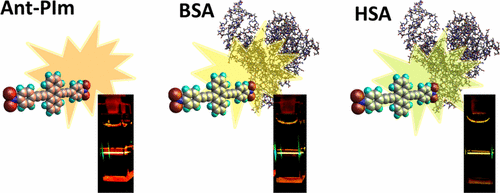Our official English website, www.x-mol.net, welcomes your
feedback! (Note: you will need to create a separate account there.)
Two-Photon Macromolecular Probe Based on a Quadrupolar Anthracenyl Scaffold for Sensitive Recognition of Serum Proteins under Simulated Physiological Conditions
ACS Omega ( IF 3.7 ) Pub Date : 2017-09-12 00:00:00 , DOI: 10.1021/acsomega.7b00665 Marco Deiana 1 , Bastien Mettra 2 , Leszek M Mazur 1 , Chantal Andraud 2 , Marek Samoc 1 , Cyrille Monnereau 2 , Katarzyna Matczyszyn 1
ACS Omega ( IF 3.7 ) Pub Date : 2017-09-12 00:00:00 , DOI: 10.1021/acsomega.7b00665 Marco Deiana 1 , Bastien Mettra 2 , Leszek M Mazur 1 , Chantal Andraud 2 , Marek Samoc 1 , Cyrille Monnereau 2 , Katarzyna Matczyszyn 1
Affiliation

|
The binding interaction of a biocompatible water-soluble polycationic two-photon fluorophore (Ant-PIm) toward human serum albumin (HSA) was thoroughly investigated under simulated physiological conditions using a combination of steady-state, time-resolved, and two-photon excited fluorescence techniques. The emission properties of both Ant-PIm and the fluorescent amino acid residues in HSA undergo remarkable changes upon complexation allowing the thermodynamic profile associated with Ant-PIm–HSA complexation to be accurately established. The marked increase in Ant-PIm fluorescence intensity and quantum yield in the proteinous environment seems to be the outcome of the attenuation of radiationless decay pathways resulting from motional restriction imposed on the fluorophore. Fluorescence resonance energy transfer and site-marker competitive experiments provide conclusive evidence that the binding of Ant-PIm preferentially occurs within the subdomain IIA. The pronounced hypsochromic effect and increased fluorescence enhancement upon association with HSA, compared to that of bovine serum albumin (BSA) and other biological interferents, makes the polymeric Ant-PIm probe a valuable sensing agent in rather complex biological environments, allowing facile discrimination between the closely related HSA and BSA. Furthermore, the strong two-photon absorption (TPA) with a maximum located at 820 nm along with a TPA cross section σ2 > 800 GM, and the marked changes in the position and intensity of the band upon complexation definitely make Ant-PIm a promising probe for two-photon excited fluorescence-based discrimination of HSA from BSA.
中文翻译:

基于四极蒽基支架的双光子高分子探针在模拟生理条件下灵敏识别血清蛋白
使用稳态、时间分辨和双光子激发的组合,在模拟生理条件下彻底研究了生物相容性水溶性聚阳离子双光子荧光团 ( Ant -PIm ) 与人血清白蛋白 (HSA) 的结合相互作用荧光技术。Ant-PIm和 HSA 中荧光氨基酸残基的发射特性在络合时发生显着变化,从而能够准确建立与Ant-PIm -HSA 络合相关的热力学曲线。蛋白质环境中Ant-PIm荧光强度和量子产率的显着增加似乎是由于对荧光团施加运动限制而导致的无辐射衰变途径衰减的结果。荧光共振能量转移和位点标记竞争实验提供了确凿的证据,证明Ant-PIm的结合优先发生在子结构域 IIA 内。与牛血清白蛋白 (BSA) 和其他生物干扰物相比,与 HSA 结合后显着的减色效应和增强的荧光增强,使得聚合物Ant-PIm探针成为相当复杂的生物环境中有价值的传感剂,从而可以轻松区分HSA和BSA密切相关。此外,强双光子吸收(TPA),最大值位于 820 nm,TPA 截面 σ 2 > 800 GM,以及络合时带的位置和强度的显着变化,无疑使Ant-PIm成为用于基于双光子激发荧光区分 HSA 和 BSA 的有前途的探针。
更新日期:2017-09-12
中文翻译:

基于四极蒽基支架的双光子高分子探针在模拟生理条件下灵敏识别血清蛋白
使用稳态、时间分辨和双光子激发的组合,在模拟生理条件下彻底研究了生物相容性水溶性聚阳离子双光子荧光团 ( Ant -PIm ) 与人血清白蛋白 (HSA) 的结合相互作用荧光技术。Ant-PIm和 HSA 中荧光氨基酸残基的发射特性在络合时发生显着变化,从而能够准确建立与Ant-PIm -HSA 络合相关的热力学曲线。蛋白质环境中Ant-PIm荧光强度和量子产率的显着增加似乎是由于对荧光团施加运动限制而导致的无辐射衰变途径衰减的结果。荧光共振能量转移和位点标记竞争实验提供了确凿的证据,证明Ant-PIm的结合优先发生在子结构域 IIA 内。与牛血清白蛋白 (BSA) 和其他生物干扰物相比,与 HSA 结合后显着的减色效应和增强的荧光增强,使得聚合物Ant-PIm探针成为相当复杂的生物环境中有价值的传感剂,从而可以轻松区分HSA和BSA密切相关。此外,强双光子吸收(TPA),最大值位于 820 nm,TPA 截面 σ 2 > 800 GM,以及络合时带的位置和强度的显着变化,无疑使Ant-PIm成为用于基于双光子激发荧光区分 HSA 和 BSA 的有前途的探针。











































 京公网安备 11010802027423号
京公网安备 11010802027423号